Wind wisdom
Making the most of those blustery days of fishing
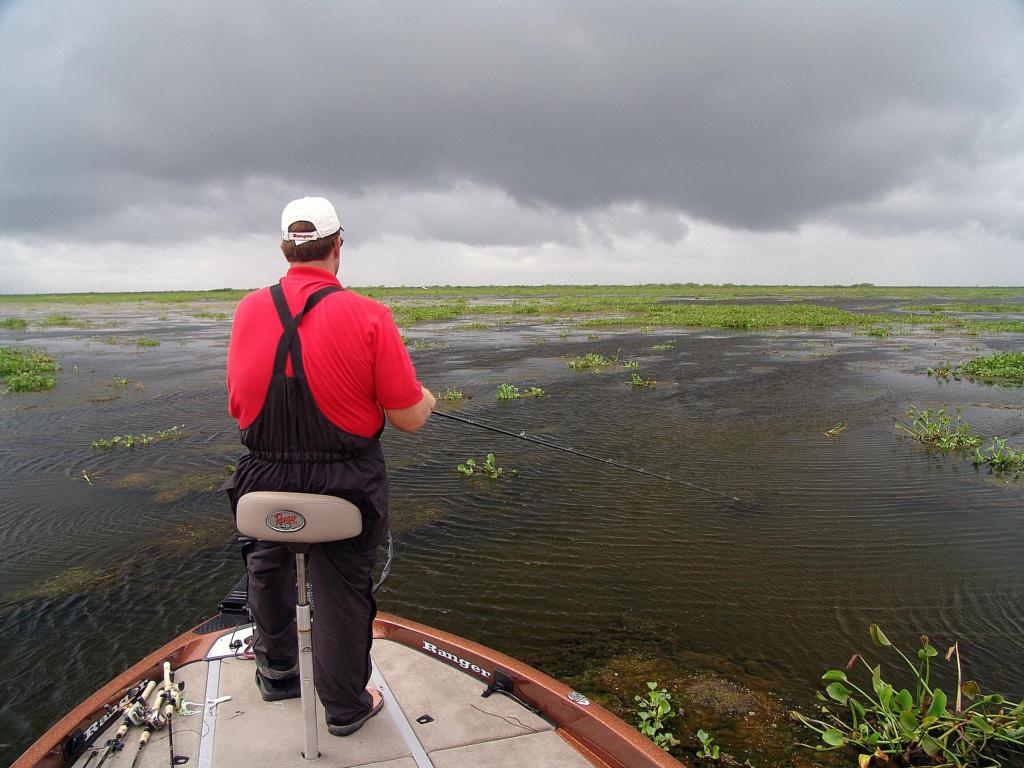
We’ve all heard that angling axiom: “Wind is your friend.” A truth, no doubt; but just like human interaction, this relationship depends on understanding habits, playing up the positives and navigating – sometimes creatively – the negatives.
Foremost, it’s helpful to embrace the fact that wind will blow when it wants to blow whether you like it or not. Now if that reminds you of someone who insists on perpetuating some annoying habit regardless of your feelings, stop right here and consider this: How much better does your day progress when you defuse the annoyance and actually find ways to put your antagonist’s momentum to good use?
And with that thought, we segue back to fishing by noting the many merits of a sporty wind. For starters, it’s a natural fan to cool your neck on hot days. It’s also a scrubbing service that stirs the water and washes the slime off of rocks that fish had been avoiding. But perhaps most importantly, wind benefits anglers in the areas of baitfish distribution and predator concealment.
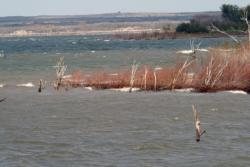 “Wind is going to position your baitfish and, wherever the baitfish are, that’s where the bass are going to be,” said pro Greg Pugh. “Wind pushes bait up onto riprap, natural rock and even mud lines. And not only the mud lines along banks – sometimes, that mud line may be 40 yards offshore. Those fish will move up in that mud line because they can hide a little better and feed on those baitfish.”
“Wind is going to position your baitfish and, wherever the baitfish are, that’s where the bass are going to be,” said pro Greg Pugh. “Wind pushes bait up onto riprap, natural rock and even mud lines. And not only the mud lines along banks – sometimes, that mud line may be 40 yards offshore. Those fish will move up in that mud line because they can hide a little better and feed on those baitfish.”
Texas pro Cody Malone agrees and points out that a good blow can stimulate a lake with some much-needed motion. “The biggest advantage is that wind creates current – bass are going to nose into the current because the bait is going to be coming with the current. So, basically, you want to be presenting your bait so it’s coming with the wind.”
For the concealment part, wind decreases visibility so fish are generally less spooky than they’d be in flat conditions. “It gives the fish a sense of security by getting that slick surface off the water,” Pugh said. “In deeper lakes, you have those big waves to make the visibility even less. Anytime you can break up your silhouette, it’s good.”
Yamaha pro David Wolack weighs in with this: “In lakes with very high clarity, the water gets a little more color to it and it decreases a fish’s chance to get a good look at your bait. They’re in a biting mood anyway when it’s windy.”
Working with the waves
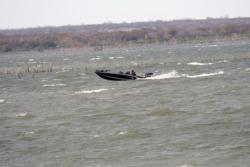 When bouncing through wind-blown waves, it’s admittedly tough on the back, sometimes tough on the stomach and always a real pain in the backside in terms of boat positioning. The key is to control the situation, make the boat go where you want it to go and do so at the rate you want it to progress.
When bouncing through wind-blown waves, it’s admittedly tough on the back, sometimes tough on the stomach and always a real pain in the backside in terms of boat positioning. The key is to control the situation, make the boat go where you want it to go and do so at the rate you want it to progress.
While that’s easier said than done, it’s nonetheless doable. For some, like Pugh, it’s actually preferable. That’s because the Alabama pro believes rough water will defeat many of his competitors – either physically, or mentally.
“Rather than getting in the back of the creeks like a lot of guys do and hiding from the wind, I’ll be sitting out in it, trying to fish it,” Pugh said. “I want the waves crashing into my boat – that’s when I know I have the kind of wind I need.”
Savvy anglers know that a dependable trolling motor, while essential, is not the entire game. Power-Poles prove invaluable when strong winds threaten to push boats over the fish too quickly. For sight-fishing, the hydraulic anchoring arms enable a fisherman to position the boat at a wind-blocking angle that leaves an otherwise choppy surface sufficiently calm for precise presentations.
“I can tell you that the Power-Pole is the most valuable piece of equipment that you can spend your money on,” Malone said. “It’s as important to me as a fishing pole. On a windy day, I’ll probably drop mine 200 to 300 times, especially if I want to crank the points or throw a ChatterBait on the points. As long as you’re in 8 feet of water or shallower – which, on southern lakes, most of the time you are – you’re going to be able to do that.”
Pugh and Wolack, both of whom rely heavily on dual Power-Poles, described windy day strategies that have served them well for open water fishing scenarios such as Lake Champlain’s heralded Ticonderoga grass beds.
Go long, stay strong
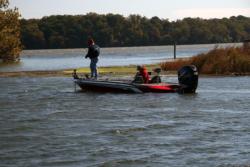 For working exposed areas, Wolak positions his boat downwind, and reverses his trolling motor to manage the drift. He’ll use his Power-Poles to drag through vegetation for additional speed control.
For working exposed areas, Wolak positions his boat downwind, and reverses his trolling motor to manage the drift. He’ll use his Power-Poles to drag through vegetation for additional speed control.
“A lot of people say that for holding boat position, fishing into the wind is the best; but in stealth situations, fishing downwind means the fish don’t hear that trolling motor (as much),” Wolak said. “Also, I think that hull slap is underestimated for its effect on fish. If you’re in a shallow weed bed and your boat is going `slap, slap, slap’ and that trolling motor is coming in and out of the water, you’re going to spook those fish.”
Sometimes, a downwind course may not be the best approach, so to keep his trolling motor in the water when big waves raise his bow, Wolak’s Minn Kota sports a 52-inch shaft. Casting around the higher profile when raised for shallow water took some adjustment, but the advantages outweigh any limitations. And because a long day of constant trolling motor and livewell operation can test even top-shelf batteries, Wolak carries a Yamaha ES-1000 generator that enables him to charge his Optimas throughout the day.
“I always rig my boat for the worst possible conditions,” Wolak said. “I may only need the (the longer shaft) 10 percent of the time, but when I do, it can make a big difference. Also, I run a 21-foot Ranger and I’d sooner have a 21-foot boat that I can run to and from my spots in rough water, rather than a smaller boat that might allow me to maneuver around a dock.”
Crustaceans and drift socks
Pugh takes a more traditional approach to the motor drift – with a slight twist. He does leverage the facing wind for boat control, but his Ranger is typically astern to the blow, with his trolling motor reversed for course adjustments.
“Sometimes those fish don’t want to hear that trolling motor,” he said. “I’ll get the back of that boat into the wind and it’s doing a couple of things: First, I’m not getting my feet wet, but I’m also able to fish off the front and concentrate on feeling that subtle bite.”
Pugh compares his windy day movement to that of a beachcombing scavenger: “If you watch a crab, he’ll run over a little way, stop and feed. He’ll sit there and feed, then he’ll scoot here, scoot there.”
“I do a lot of zig zagging and a lot of cutting back and forth. I’m trying to locate a wad of fish that nobody else is able to find, so I’m moving across that grass like a crab, rather than trying to fish in a straight line or right down the edge of a grass line. That’s where your Power-Poles come in – you just let the wind blow you across the grass 10-15 yards, then drop your Power-Poles down to stop yourself in that grass.”
Pugh has another innovative use for Power-Poles: “They actually make a difference in deeper water, too, because you can rig your drift sock off the (shafts) and work them with the PowerPoles by moving them up and down. It’s a lot easier making those drifts when you don’t have to fight with the trolling motor.”
This strategy proves essential in areas such as upstate New York’s 1000 Islands, where dragging tubes can yield huge smallmouth. When windy days require heavier heads to maintain bottom contact during a fast drift, anglers sacrifice sensitivity. However, drift socks slow the pace and allow the more productive presentation of lighter tubes.
Productive baits
Most agree that a windy-day conditions make moving baits the right choice. Pugh favors a 3/8- to 1/2-ounce Hog Caller spinnerbait, typically in chartreuse and white. He uses a tandem model with a No. 4 silver Colorado blade for some fish-calling “thump” with a No. 4 gold willow blade to mimic the baitfish bass seek. (Florida angler Mike Faust takes the baitfish impersonation to the extreme with a 3/8-ounce Booyah Super Shad spinnerbait sporting four willows.)
“It seems that no matter how much the fish see a spinnerbait, they’ll still eat it,” Pugh said. “At some point, that spinnerbait is going to come through some baitfish and those fish are going to see it.”
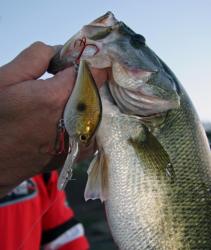 Wolak commonly throws a Jackall Muscle Deep 10+ crankbait, however, he monitors where strikes occur and notes any deep trends. When wind current runs low, he said, the fish may hold behind bottom structure where a jig or Texas-rigged plastic might be a wise call.
Wolak commonly throws a Jackall Muscle Deep 10+ crankbait, however, he monitors where strikes occur and notes any deep trends. When wind current runs low, he said, the fish may hold behind bottom structure where a jig or Texas-rigged plastic might be a wise call.
For long casts in windy conditions, Pugh’s a fan of Berkley Crystal line, which blends the strength and sensitivity of braid with fluorocarbon’s low visibility. Setting hooks can be tough when the wind blows a bow in your line, but Pugh points out the upside of a blustery day.
“There are times when the wind will enable you to use a larger diameter line,” he said. “Where you might be using 6-pound fluorocarbon on a calm day, if the wind comes up, you can go up to your 15-, 17- or 20-pound lines.”
In any case, don’t expect an easy ride. But when white foam streaks the lake, you can expect big opportunities.
“Some of the most tiring days I’ve had on the water were windy days because they wear you out,” Pugh said. “But if you learn to work with it, you can catch a lot of fish on windy days.”